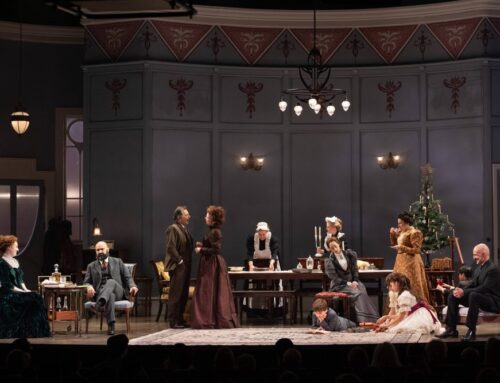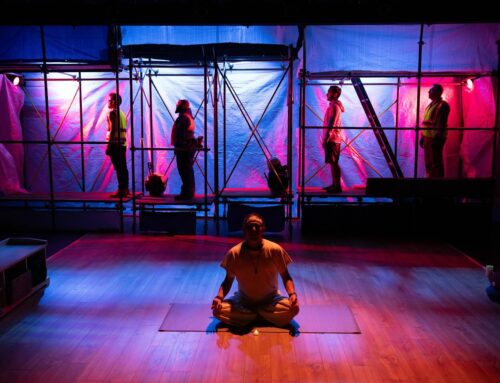Our two great regional theater companies have mounted ambitious productions: Huntington Theatre Company’s ROMEO AND JULIET charts a tragic end, while American Repertory Theater’s ENDLINGS is an interesting beginning.
 We all know how Romeo and Juliet end up. The challenge is to find a fresh way to envision this tragedy of star-crossed lovers whose feuding households suck them into an increasingly widening vortex of revenge, until their only way out is suicide in each other’s arms. The tale is hyper relevant in these deeply divided times, and the Huntington rises to the occasion with a supercharged production and a cavalcade of local stars. They perhaps overshoot with an excess of frenzy that almost overwhelms the tenderness of the tale. We know we are in “up to the minute” territory as the matriarchs of each family– Lady Montague (Celeste Oliva in a cropped jumpsuit) and Lady Capulet (Marianna Bassham in heels and a little black dress)– lean in and deliver the prologue.
We all know how Romeo and Juliet end up. The challenge is to find a fresh way to envision this tragedy of star-crossed lovers whose feuding households suck them into an increasingly widening vortex of revenge, until their only way out is suicide in each other’s arms. The tale is hyper relevant in these deeply divided times, and the Huntington rises to the occasion with a supercharged production and a cavalcade of local stars. They perhaps overshoot with an excess of frenzy that almost overwhelms the tenderness of the tale. We know we are in “up to the minute” territory as the matriarchs of each family– Lady Montague (Celeste Oliva in a cropped jumpsuit) and Lady Capulet (Marianna Bassham in heels and a little black dress)– lean in and deliver the prologue.
Under the direction of Peter DuBois, the first half moves at a frantic pace as a brawl erupts in what looks like an office building and quickly becomes a conflagration of Capulets and Montagues. A parade of local stars are seen kicking, punching, slugging, wrestling: even tempered Benvolio (Omar Robinson) and fiery Tybalt (John Zdrojeski), the aforementioned matriarchs and their mates, limping Lord Montague (Nael Nacer) and an explosive Lord Capulet (Maurice Emmanuel Parent), until The Prince of Verona (Ed Hoopman in a suit) pops out onto a balcony to call these feuding households to order. (Would that Nancy Pelosi could could do the same…)
Marianna Bassham steals every scene she’s in as Juliet’s mom, who’s got it goin’ on with her big hair, flashy wardrobe, and clearly active sex life with Mr. Capulet. But despite her self-absorption this Mrs. Montague’s agony at Juliet’s death is real and heartbreaking. Nancy E. Carroll is off beat and on target as Juliet’s beloved nurse; she’s a scold and a softy, a yakker and a master of the silent pause, on which we all hang awaiting her next stony utterance. Dale Place as a bumbling serving man and later apothecary, had us in stitches in a role I seldom notice!
Enter our hero, the easily aroused Romeo, lovesick over the soon to be forgotten Rosaline when he sets eyes on Juliet, Capulet daughter of the Montague’s sworn enemies. As played by George Hampe, Romeo is handsome and cocky, and as fidgety as his affections. Hampe initially overacts, but does find new rhythms in the lines and settles down when he spots the lovely Juliet (Lily Santiago in a matching set of angel wings) at the ball. They are both swept off their feet, literally, in a whimsically choreographed pas de deux that begins with their being hoisted aloft as the crowd below disappears. It’s a beautiful, and evocatively staged scene, suggesting a transporting love that will lead them, sadly, out of this world.
Santiago’s Juliet is charming and maybe more savvy than her soon to be husband, though she’s not as facile an actress navigating contradictory emotions. When she lashes out at Romeo for killing Tybalt, then immediately steps it back, there’s nothing in her performance that bridges the divide. But these two absolutely spark off each other igniting the bloody events to follow.
At the end of the first half, I overheard the woman behind me say, “I’m exhausted.” Well, get ready for the second half. That’s when the knives come out, and the bats, and the blood (warning to anyone who suffers from the fainting vasovagal response). And the star performances just keep on coming. Will Lyman, surprised me as the ineffectual Friar Laurence who seals the marriage, but bungles the messaging which leads to their deaths. Lyman’s inescapable elegance and dignity onstage is almost too much for the role to bear. The final scene as the deaths pile up, is awkwardly choreographed; as Romeo and Juliet take turns killing themselves, they seemed about to tumble off the LED lighted bier. The production as a whole is precariously perched, sometimes losing its emotional balance and focus on the hearts of the young lovers caught in the fray. Through March 31.
ENDLINGS is a trip. Presented by the AMERICAN REPERTORY THEATER, it’s like nothing you’ve ever quite seen onstage before. It is by turns, beautiful, funny, brilliant, indulgent, naive, wondrous. It feels like the beginnings of three separate plays, a strange theatrical hybrid that has yet to find its connective tissue.
The play by Celine Song is meta, squared. It’s about the thing itself, twice removed, as the playwright contemplates her artistry, ancestry, and layered identity: Korean by way of Seoul, Toronto, and Manhattan. ENDLINGS begins on another island, Man-Jae, where three elderly Korean women called haenyeos, are the last in a long line of women who live by diving deep for sustenance. We listen as they talk about their solitary lives, and watch as they leap into the ocean. WE SEE THEM DO IT! I can’t imagine what that set must have required.
The second strand pulls us outside this story into the writing of this story, and focuses on the playwright, “Ha Young” (Celine’s original Korean name), who jumps off the stage and later out of the audience, and right through the fourth wall to explain her own convoluted history and justify her misgivings about realizing her identity through her art. Having evolved out of writing “white plays,” she is now writing this “Asian play,” and we see her in and out of the process, struggling with the guilt of bartering her heritage–selling her skin– in a bid for authenticity and to make a living. In an amusing sequence she does a number on her “white husband” who sits beside her wearing a sign identifying him as such, and mincing words around his critique of the play she’s writing that we’re watching.
The third story strand begins Act II and is a sort of mini play starring the stagehands whom we have been watching change the set in the play we are watching. They riff satirically on themselves as white male viewers, and we find ourselves laughing at and questioning the various ways in which the white, western male gaze taints what we see. Brilliant.
The visuals astound: crisply graphic, horizontal settings akin to the primary colored cutouts you’d find in a children’s book or a painting by Magritte. The top layer is a gorgeous horizon of mist, sea, sky, and sometimes three little houses silhouetted against the deep blue night. Below, eventually appears a stretch of black and white Manhattan skyline, and below that, is the ocean into which they all leap, separately and together, our view eventually expanding from individual windows to the wider sea. These are the layers of history, real estate, and experience the playwright is exploring, and she has a lot on her mind.
I found myself impatient with much of the self-conscious examination, when what I think she wanted and what I wanted, was to just dive in, and float. We’re living in a time where boundaries are blurrier than ever, and the struggle between letting go and hanging on is hard. So I loved the final scene in which Ha Young re-enters her play, connects with one of the elder women, embracing her ancestors and her legacy, and understands that what there is, is to exist. Dive in through March 17.








Leave A Comment
You must be logged in to post a comment.